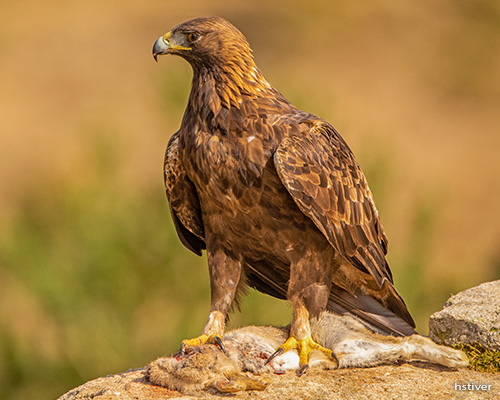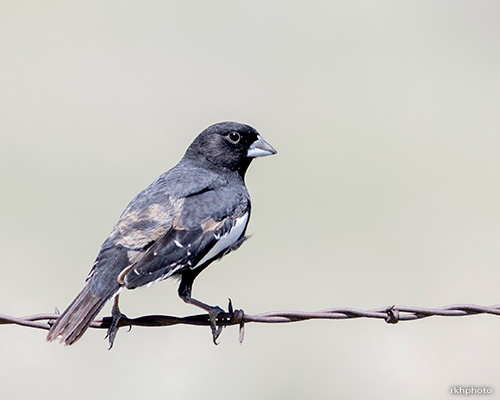Birdwatching in Colorado
Birdwatching in Colorado
Birdwatching is a fascinating hobby, and Colorado has an abundance of species. In fact, the Colorado Birds Records Committee recognizes over 500 species of birds in Colorado (507, to be exact). Not all of them live in Colorado year-round, but spring is a great time to see a lot of unique species while they migrate back north for the summer. So, get yourself a pair of binoculars, and whether you’re enjoying a peaceful hike in the mountains or a relaxing day in your own backyard, keep an eye out for some of these beautiful birds in Colorado. Many Colorado State Parks feature birdwatching stations and provide educational material about the area's birds.Lark Bunting Birdwatching
Birdwatching for Eagles in Colorado
Bald Eagle
 This gorgeous bird of prey needs no introduction; it’s the national bird of the United States of America, and its regal white head and yellow beak can be found on everything from our country’s official seals to bumper stickers and t-shirts. After a long and concerted conservation effort, the bald eagle’s population is rising and no longer considered an endangered species. The eagles can be spotted throughout Colorado, especially in the winter season when many of them stop in the Centennial State on their way north, though some do live in Colorado year-round. If you’re birdwatching for a bald eagle, keep an eye on areas near reservoirs, where the birds often perch on high trees or can be spotted fishing in the water.
This gorgeous bird of prey needs no introduction; it’s the national bird of the United States of America, and its regal white head and yellow beak can be found on everything from our country’s official seals to bumper stickers and t-shirts. After a long and concerted conservation effort, the bald eagle’s population is rising and no longer considered an endangered species. The eagles can be spotted throughout Colorado, especially in the winter season when many of them stop in the Centennial State on their way north, though some do live in Colorado year-round. If you’re birdwatching for a bald eagle, keep an eye on areas near reservoirs, where the birds often perch on high trees or can be spotted fishing in the water.
Golden Eagle
 These majestic raptors are another common symbol of Colorado, with dark brown feathers, golden heads, and necks that give them their name. Juvenile golden eagles have white patches on their wings. They’re pretty common in the Western US, and while many of them call Colorado home year-round, plenty of others migrate to the Centennial State during the winter months. Golden eagles are more solitary than Bald eagles, and they live in the plains, mountains, and both open and rugged terrain.
These majestic raptors are another common symbol of Colorado, with dark brown feathers, golden heads, and necks that give them their name. Juvenile golden eagles have white patches on their wings. They’re pretty common in the Western US, and while many of them call Colorado home year-round, plenty of others migrate to the Centennial State during the winter months. Golden eagles are more solitary than Bald eagles, and they live in the plains, mountains, and both open and rugged terrain.
Popular Birdwatching Species
Rufous Hummingbird
 Bright orange in color, these little guys are sometimes called the feistiest breed of hummingbird because of their tendency to fight off other hummingbirds from feeders and flowers aggressively. Rufous hummingbirds migrate through Colorado in late summer or fall when they return to Mexico for winter. They’re not the only hummingbird in Colorado—broad-tailed hummingbirds, with their red throats and green feathers, can be seen at higher elevations and in the sub-alpine meadows of the western half of the state, and Calliope hummingbirds, which have vibrant magenta throat feathers and iridescent green bodies, are also common. If you want to attract hummingbirds to your backyard feeder, try to do so during their early spring or late fall migration.
Bright orange in color, these little guys are sometimes called the feistiest breed of hummingbird because of their tendency to fight off other hummingbirds from feeders and flowers aggressively. Rufous hummingbirds migrate through Colorado in late summer or fall when they return to Mexico for winter. They’re not the only hummingbird in Colorado—broad-tailed hummingbirds, with their red throats and green feathers, can be seen at higher elevations and in the sub-alpine meadows of the western half of the state, and Calliope hummingbirds, which have vibrant magenta throat feathers and iridescent green bodies, are also common. If you want to attract hummingbirds to your backyard feeder, try to do so during their early spring or late fall migration.
Northern Flicker

Northern flickers are spotted across their bodies, with vibrant yellow tones in their tails and wings and dusty orange heads with a distinctive bright red spot. Northern flickers can be found in many parts of Colorado and at all elevations up to the timberline. They’re part of the woodpecker family but prefer peaking at the ground for insects rather than trees.
American Dipper

With unassuming grey bodies and thin, pointed beaks, American Dippers aren’t the most distinctive birds by appearance, but they are actually really unique in that they’re the only aquatic songbirds in North America. You might find an American Dipper hunting for insects in the shallow rivers and stony creeks of the Rocky Mountains or hear its clear, ringing “zeet” call while out on a peaceful hike.
Boreal Owl Birdwatching
 Boreal Owls are usually found much further north than Colorado, and the Centennial State is the furthest southernmost region of their natural range. Boreal owls are small with bright yellow eyes, and in Colorado, you’ll find them in high alpine areas where it stays cold for much of the year. Boreal owls are pretty hard to spot, so you’ll have to be patient and methodical—and probably a pretty experienced hiker up for a challenge—to lay eyes on one of these shy birds.
Boreal Owls are usually found much further north than Colorado, and the Centennial State is the furthest southernmost region of their natural range. Boreal owls are small with bright yellow eyes, and in Colorado, you’ll find them in high alpine areas where it stays cold for much of the year. Boreal owls are pretty hard to spot, so you’ll have to be patient and methodical—and probably a pretty experienced hiker up for a challenge—to lay eyes on one of these shy birds.
Lewis’ Woodpecker
 Lewis ' Woodpecker is a flashy bird easily recognizable with a red face, pink abdomen, and a dark green body with a silver collar. Named for the famous explorer Meriwether Lewis, this woodpecker can often be found in tall pine groves throughout the mountains and the staglike remnants of forest fires. Despite the name woodpecker, Lewis’ woodpecker doesn’t actually peck at tree trunks for food—it hunts by catching insects in midair. Lewis’ woodpecker can be found foraging for nuts outside of the breeding season.
Lewis ' Woodpecker is a flashy bird easily recognizable with a red face, pink abdomen, and a dark green body with a silver collar. Named for the famous explorer Meriwether Lewis, this woodpecker can often be found in tall pine groves throughout the mountains and the staglike remnants of forest fires. Despite the name woodpecker, Lewis’ woodpecker doesn’t actually peck at tree trunks for food—it hunts by catching insects in midair. Lewis’ woodpecker can be found foraging for nuts outside of the breeding season.
White-Breasted Nuthatch
 Named for their tendency to jam nuts into cracks in tree bark and hammer at them with their beaks to ‘hatch’ them open, there are three different varieties of nuthatches found throughout Colorado: the pygmy nuthatches of the mountain ponderosa forests, the intra-state migratory red-breasted nuthatches, which head to the northern parts of Colorado in the summer, and the southern regions of Colorado in the winter, and the white-breasted nuthatch, which nests in trees and has the unusual habit of cleaning up after itself every day by removing any wayward droppings each morning when it wakes up. Nuthatches like trees, so if you live with plenty of trees, chances are, you’ll spot a nuthatch.
Named for their tendency to jam nuts into cracks in tree bark and hammer at them with their beaks to ‘hatch’ them open, there are three different varieties of nuthatches found throughout Colorado: the pygmy nuthatches of the mountain ponderosa forests, the intra-state migratory red-breasted nuthatches, which head to the northern parts of Colorado in the summer, and the southern regions of Colorado in the winter, and the white-breasted nuthatch, which nests in trees and has the unusual habit of cleaning up after itself every day by removing any wayward droppings each morning when it wakes up. Nuthatches like trees, so if you live with plenty of trees, chances are, you’ll spot a nuthatch.







